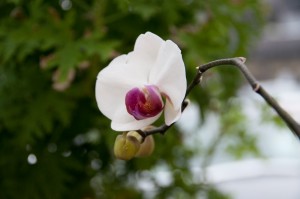MWRD: Biosolids grow in popularity for nurturing plants
By Kevin Beese For Chronicle Media — February 16, 2016

Plants grow in the MWRD greenhouse. (Photo courtesy of Metropolitan Water Reclamation District of Greater Chicago)
Last in a three-part series looking at how operations at the Metropolitan Water Reclamation District of Greater Chicago’s Stickney plant — the largest water treatment plant in the world — benefit residents.
Two rows of what are supposed to be identical potted plants are placed across from each other in the greenhouse of the Metropolitan Water Reclamation District’s Stickney treatment facility. The plants are in striking contrast to one another.
The difference in the plants could be the stuff of “before” and “after” photos in a magazine or newspaper. While both rows of plants are healthy, the ones treated with the MWRD’s own special concoction are much bigger, greener and heartier.
Lakhwinder Hundai, supervising environmental soil scientist with the Water Reclamation District, says the use of biosolids on the flourishing plant is the difference.
“Putting regular fertilizer in the soil plants only get some of the nutrition they need. They get three or four things,” Hundai said. “Biosolids are going to provide 16 nutritional items.”
The soil scientist said there is a night-and-day difference in the performances of regular fertilizers and biosolids.

A flower blooms in the MWRD greenhouse. (Photo courtesy of Metropolitan Water Reclamation District of Greater Chicago)
“Fertilizer is a synthetic. It doesn’t have much substance. It is more like a chemical,” Hundai said. “Biosolids provide nutrition in the soil and the plant reacts.”
| Biosolids are a product of wastewater treatment in which organic solids that have settled out during the treatment process are sent to temperature-controlled digesters where microorganisms break them down in a process similar to composting. At the MWRD, the biosolids are generated by following U.S. Environmental Protection Agency-approved processes and meet the USEPA’s most stringent criteria for Exceptional Quality biosolids.
Raw sewage undergoes a series of physical, chemical and biological processes to clean the wastewater and remove the solids, commonly referred to as sludge. While clean water is discharged in local waterways, sludge is processed in anaerobic digesters for approximately 25-50 days at less than 95 degrees to destroy pathogens and easily degradable organic compounds (volatile solids) to minimize odor potential. At this stage, the solids are distinguished as biosolids and not sludge. A team of 13, six with doctorate degrees, work in the MWRD’s Stickney greenhouse, testing the effects of biosolids on the growing process. “It is the only location where six PhD soil scientists are in one place,” Hundai said. Why, with the stark difference in performance, do people stick with fertilizer for their lawns and plants? Hundai said that people stay with what they know, the fertilizer companies spend a lot on advertising and that biosolids are still an unknown to most people. The MWRD is working to change that last fact by making information about biosolids more readily available to residents and providing its end product more easily to area residents. Hundai said because the MWRD is a nonprofit agency, it is not looking to get into the fertilizer business and make money off the sale of biosolids. Hundai noted that the MWRD has been providing biosolids to public and private golf courses and athletic fields in the Chicago area for more than 30 years to rave reviews. Helping to reduce some residents’ fears about biosolids, Gov. Bruce Rauner this summer signed legislation to amend the Illinois Environmental Protection Act to recognize EQ biosolids as a resource and not as waste. The legislation recognizes biosolids as safe and urges their use on lawns and crops. Individuals interested in using MWRD biosolids should email an agency soil scientist at biosolids@mwrd.org.
Related content: Treating area’s waste a massive undertaking Related content: Microbes do the work to purify Cook County’s water — Biosolids grow in popularity for nurturing plants —
|







